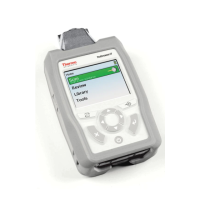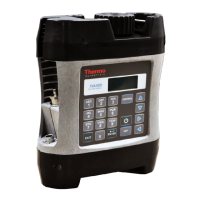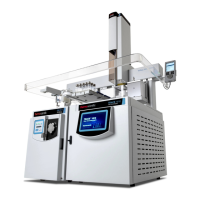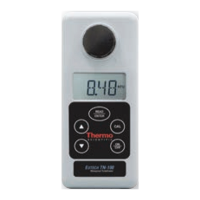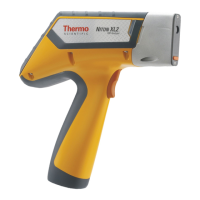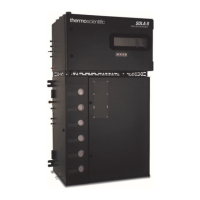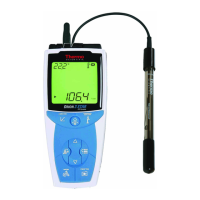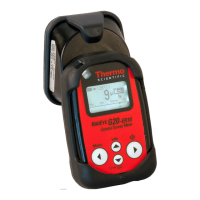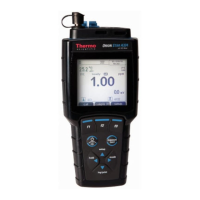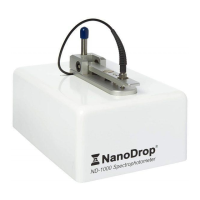Do you have a question about the Thermo Scientific TruNarc and is the answer not in the manual?
Provides contact details for customer support via telephone, email, website, and mail.
Details hazards associated with Class IIIB laser, including exposure, reflections, and distance requirements.
Emphasizes the need for user training before operating the analyzer to prevent hazards.
Instructs users to check for cracks in the laser aperture and to stop use if cracked.
Warns about scanning thermally sensitive materials on dark surfaces or filter paper, which can cause ignition.
Advises users to avoid pointing the instrument at eyes and staying outside the laser hazard zone.
Identifies key components of the TruNarc analyzer's front panel, including display, keys, and laser indicator.
Illustrates and labels the side and bottom components of the TruNarc analyzer, including ports and apertures.
Lists the accessories included in the TruNarc analyzer carrying case, including cables and software.
Explains how to position the self-check standard for diagnostic tests.
Details the procedure for powering the TruNarc analyzer on and off using the bottom key.
Describes the process of activating the analyzer's laser by entering a code after training.
Provides instructions for opening and closing the analyzer's access door, noting loss of resistance when open.
Explains how to recharge the analyzer's internal battery using an electrical outlet or USB port.
Guides on setting date/time via Admin software and using wall plug adapters.
Outlines essential safety precautions, including training, avoiding certain materials, and handling thermally sensitive substances.
Lists detailed safety practices for scanning, including distance, eye protection, and handling of sensitive materials.
Explains how to properly position the laser sample point for optimal scan results.
Describes the diagnostic self-check procedure to verify analyzer operation and its possible results.
Provides step-by-step instructions for performing the self-check diagnostic test on the analyzer.
Explains how to interpret Pass and Fail results from the self-check and when to contact support.
Offers guidance on scanning substances in various containers like plastic bags and thin-walled containers.
Provides scanning best practices for powders, pills, capsules, crack pipes, and solid materials.
Details the steps for initiating and performing a scan, including using the Scan Ready and Delay screens.
Explains how to interpret various scan results, including Alarm, Clear, and Acetaminophen (paracetamol) results.
Describes Precursor/chemical, Inconclusive, and Polystyrene Warning scan results and their meanings.
Guides users on how to review stored scan and self-check results on the analyzer.
Explains the purpose and technology of the Solution Kit (Type H) for analyzing challenging narcotics.
Details the steps for preparing the ethanol vial and test stick package before conducting a scan.
Begins the step-by-step guide for performing a scan using the Solution Kit (Type H) test stick.
Continues the procedure for using the Solution Kit (Type H), including immersing the stick and initiating the scan.
Completes the scan procedure, showing how to hold the stick and analyzer during the scan.
Provides specific preparation instructions for scanning black tar heroin using the Solution Kit.
Explains how to interpret scan results obtained using the Solution Kit, including specific warnings.
Advises on the proper disposal of used test sticks and ethanol vials according to organizational policies.
Identifies and describes the main components of the TruNarc Admin Software interface.
Explains renaming, changing order, and entering text into columns in the Admin software.
Explains the process of transferring scan data from the analyzer to the Admin software.
Guides users on how to search scan results using keywords within the software.
Details how to search for scan results by specifying a start and end date.
Explains how to remove scan results from the analyzer, noting the need to sync first.
Describes how to generate, preview, print, and save scan reports in PDF format.
Explains how to replace the default logo with a custom image on generated reports.
Details the process of exporting scan results in various formats like CSV, SPC, and ARB.
Guides users on how to view the list of substances that produce specific results in the analyzer's library.
Guides on adjusting analyzer's date, time, zone, and display language via Admin software.
Shows how to find software version and edit account information via the Customer Support website.
Directs users to access operator training materials within the Admin software.
Explains how to send scan results to Customer Support for analysis and assistance.
Provides instructions for cleaning components and the analyzer exterior.
Advises on how to order replacement test sticks and ethanol vials for the Solution Kit.
Explains where to find the analyzer's serial number on the device itself.
Guides users on how to purchase scan credits online for the Pay-Per-Scan configuration.
Details the process of transferring purchased scan credits to the analyzer(s).
Explains how to verify if scan credits have been successfully transferred to the analyzer.
Outlines the procedure for returning the analyzer for repair, including obtaining an RMA number.
Specifies operator qualifications and introduces chapter on safety features like Scan Ready and Scan Delay.
Describes the Scan Ready screen, its warnings, and options for starting, delaying, or canceling a scan.
Explains how to use the Scan Delay option to specify a time before the scan starts, allowing users to move to a safe area.
Details the fixed scan timeout feature that limits scan duration for operator safety.
Explains how to use the vial holder for safely scanning small amounts of material in uncapped vials.
Describes laser, electrical, and chemical safety labels and WEEE directive compliance.
States compliance with the European Union's Waste Electrical & Electronic Equipment (WEEE) Directive.
Outlines the terms and conditions of the product's limited warranty, including coverage and exclusions.
Details specific conditions that void the warranty and exclusions from coverage.
Provides contact details for customer support via telephone, email, website, and mail.
Details hazards associated with Class IIIB laser, including exposure, reflections, and distance requirements.
Emphasizes the need for user training before operating the analyzer to prevent hazards.
Instructs users to check for cracks in the laser aperture and to stop use if cracked.
Warns about scanning thermally sensitive materials on dark surfaces or filter paper, which can cause ignition.
Advises users to avoid pointing the instrument at eyes and staying outside the laser hazard zone.
Identifies key components of the TruNarc analyzer's front panel, including display, keys, and laser indicator.
Illustrates and labels the side and bottom components of the TruNarc analyzer, including ports and apertures.
Lists the accessories included in the TruNarc analyzer carrying case, including cables and software.
Explains how to position the self-check standard for diagnostic tests.
Details the procedure for powering the TruNarc analyzer on and off using the bottom key.
Describes the process of activating the analyzer's laser by entering a code after training.
Provides instructions for opening and closing the analyzer's access door, noting loss of resistance when open.
Explains how to recharge the analyzer's internal battery using an electrical outlet or USB port.
Guides on setting date/time via Admin software and using wall plug adapters.
Outlines essential safety precautions, including training, avoiding certain materials, and handling thermally sensitive substances.
Lists detailed safety practices for scanning, including distance, eye protection, and handling of sensitive materials.
Explains how to properly position the laser sample point for optimal scan results.
Describes the diagnostic self-check procedure to verify analyzer operation and its possible results.
Provides step-by-step instructions for performing the self-check diagnostic test on the analyzer.
Explains how to interpret Pass and Fail results from the self-check and when to contact support.
Offers guidance on scanning substances in various containers like plastic bags and thin-walled containers.
Provides scanning best practices for powders, pills, capsules, crack pipes, and solid materials.
Details the steps for initiating and performing a scan, including using the Scan Ready and Delay screens.
Explains how to interpret various scan results, including Alarm, Clear, and Acetaminophen (paracetamol) results.
Describes Precursor/chemical, Inconclusive, and Polystyrene Warning scan results and their meanings.
Guides users on how to review stored scan and self-check results on the analyzer.
Explains the purpose and technology of the Solution Kit (Type H) for analyzing challenging narcotics.
Details the steps for preparing the ethanol vial and test stick package before conducting a scan.
Begins the step-by-step guide for performing a scan using the Solution Kit (Type H) test stick.
Continues the procedure for using the Solution Kit (Type H), including immersing the stick and initiating the scan.
Completes the scan procedure, showing how to hold the stick and analyzer during the scan.
Provides specific preparation instructions for scanning black tar heroin using the Solution Kit.
Explains how to interpret scan results obtained using the Solution Kit, including specific warnings.
Advises on the proper disposal of used test sticks and ethanol vials according to organizational policies.
Identifies and describes the main components of the TruNarc Admin Software interface.
Explains renaming, changing order, and entering text into columns in the Admin software.
Explains the process of transferring scan data from the analyzer to the Admin software.
Guides users on how to search scan results using keywords within the software.
Details how to search for scan results by specifying a start and end date.
Explains how to remove scan results from the analyzer, noting the need to sync first.
Describes how to generate, preview, print, and save scan reports in PDF format.
Explains how to replace the default logo with a custom image on generated reports.
Details the process of exporting scan results in various formats like CSV, SPC, and ARB.
Guides users on how to view the list of substances that produce specific results in the analyzer's library.
Guides on adjusting analyzer's date, time, zone, and display language via Admin software.
Shows how to find software version and edit account information via the Customer Support website.
Directs users to access operator training materials within the Admin software.
Explains how to send scan results to Customer Support for analysis and assistance.
Provides instructions for cleaning components and the analyzer exterior.
Advises on how to order replacement test sticks and ethanol vials for the Solution Kit.
Explains where to find the analyzer's serial number on the device itself.
Guides users on how to purchase scan credits online for the Pay-Per-Scan configuration.
Details the process of transferring purchased scan credits to the analyzer(s).
Explains how to verify if scan credits have been successfully transferred to the analyzer.
Outlines the procedure for returning the analyzer for repair, including obtaining an RMA number.
Specifies operator qualifications and introduces chapter on safety features like Scan Ready and Scan Delay.
Describes the Scan Ready screen, its warnings, and options for starting, delaying, or canceling a scan.
Explains how to use the Scan Delay option to specify a time before the scan starts, allowing users to move to a safe area.
Details the fixed scan timeout feature that limits scan duration for operator safety.
Explains how to use the vial holder for safely scanning small amounts of material in uncapped vials.
Describes laser, electrical, and chemical safety labels and WEEE directive compliance.
States compliance with the European Union's Waste Electrical & Electronic Equipment (WEEE) Directive.
Outlines the terms and conditions of the product's limited warranty, including coverage and exclusions.
Details specific conditions that void the warranty and exclusions from coverage.
| Technology | Raman Spectroscopy |
|---|---|
| Battery Life | Up to 4 hours |
| Detection Capability | Narcotics, Stimulants, Depressants, Hallucinogens, Cutting Agents |
| Portability | Handheld |
| Connectivity | USB, Wi-Fi |
